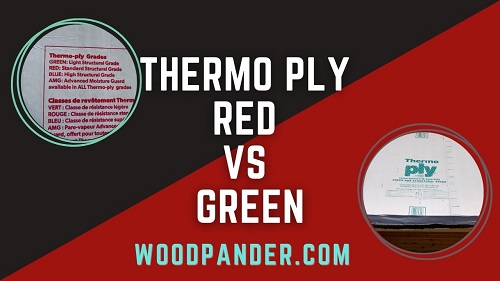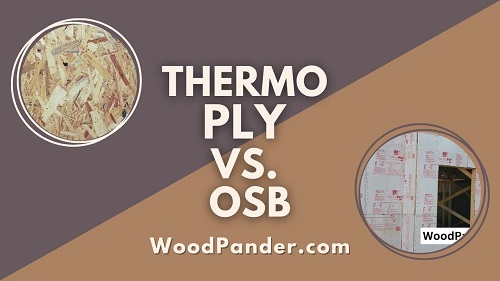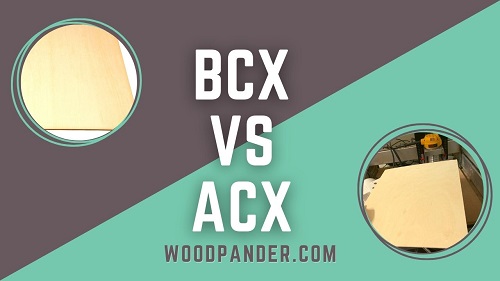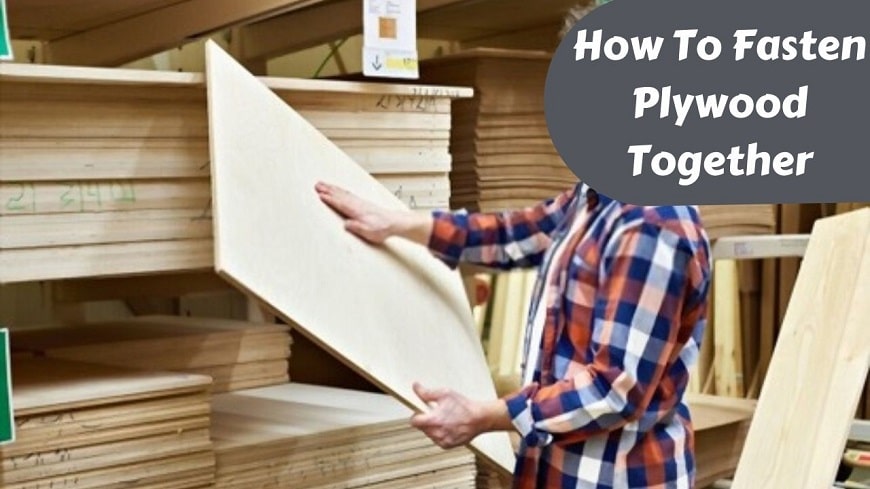When it comes to constructing a building, you get to choose the best materials possible. Hence, people often get confused between thermo ply vs plywood. Both these sheathing materials are used for the same purposes but they are not the same.
Thermo ply and plywood are two different things. They are made by following separate methods. Both materials are made of layers of wood. However, thermo-ply joints the wood pieces with glue under the control of heat and high pressure. Whereas, plywood is just made of glued wood pieces. Therefore, they also have different kinds of privileges.
So, to let you know more we have come up with a complete discussion between thermo-ply and plywood. We are also adding a precise comparison table below to make you more acknowledged.
Thermo Ply vs Plywood : A Comprehensive Comparison for DIY Enthusiasts
| Properties | Thermo-Ply | Plywood |
| Weight and Thickness | Lightweight and 1/4″ | Heavy and 1” |
| Strength | Stronger | Strong |
| Durability | Less durable | Highly durable |
| Moisture Resistance | Less resistant | Highly resistant |
| Integrity | Less | High |
| Ductility | High | Less |
| Appearance | Uniform | Natural |
| Cost | Expensive | Cheap |
One of our articles –Thermo Ply Vs OSB.
What is Thermo Ply Structural Sheathing Board?
Many people out there confuse thermo-ply with plywood. But even though both materials are made of wooden pieces, they differ in the case of wood materials. Thermo ply is mainly constructed with wood chips.
These wood chips are first mixed with several adhesives and resins. Then these chips are pressed together until they transform into a shape of solid sheet. However, manufacturers use pressure and heat to produce this material. hence, thermo-ply is meant to be stronger and sturdier.
Again, this composite material comes with many other advantages. It is a natural insulator that also comes with an attractive appearance. Moreover, thermo-ply is also useful in making tables, cabinets, and other furniture.
Nonetheless, there are several types of thermo-ply available in the market. All of them are made of common materials but have different features. The types are,
- Decorative thermo ply
- Flush cut thermo ply
- Engineered thermo ply
- Foil-faced thermo ply
These different types of thermo-ply are used for different purposes. Yet, all these types are easy to handle.
Things We Liked about ThermoPly / Pros
- The product is versatile and can be used for making furniture, insulating ceilings and walls, and others.
- The material is lightweight and easy to drill, cut, fasten, or handle.
- It is highly resistant to mold, insects, fire, and other odds.
- A great option for acoustical or thermal properties.
Things We Didn’t Like about ThermoPly / Cons
- They come at an expensive rate.
- They are not recyclable or environment-friendly.
One of our articles –
What is Plywood?
Plywood is also arguably one of the most popular insulating materials for construction projects. It is also made of wood layers like the former one we have just discussed. However, in plywood construction wooden veneers are used.
These wooden veneers are also known as wooden strips. The long strips are glued side by side to form a solid layer. Then several layers are added on top of each layer to create plies of a cross-grain pattern. The final product is highly resistant and durable.
Moreover, this insulating material also does not split while splitting. However, plywood also uses quality adhesive for joining each layer. Like thermo-ply, plywood also comes in several types and grades. These are also used for many different purposes. However, the types include,
- Softwood plywood
- Hardwood plywood
- OSB or Particle board
- Marine plywood
- Pressure-treated plywood
- Waferboard plywood
All these types serve several purposes and come in distinct features yet are made of common materials.
Things We Liked about Plywood / Pros
- Easily available and comparatively less expensive.
- Strong material and resistant to cracking, warping, or splitting.
- Used in a wider range of sectors including building boats or other projects.
- The material is easy to handle and work with.
Things We Didn’t Like about Plywood / Cons
- Less susceptible to mold and other water damage.
- Comparatively less strong and less durable.
Differences Between Thermo Ply and Plywood
Well, even though both these sheathing boards are similar to some extent yet they differ from each other in terms of several properties. Let’s discuss their differences.
Weight and Thickness
Needless to say, due to the type of wood, plywood tends to have more weight than thermo-ply. Plywood has denser material. That is why this sheathing material is also thicker. It comes with a thickness of around 1inch.
On the other hand, the material of thermo-ply is not dense. So, its thickness is also less and it is around 1/4-inch. Therefore, thermo-ply is lightweight. Whereas, plywood is a bit heavy.
Strength
Both thermo-ply and plywood is engineered material. But as we mentioned earlier, thermo-ply has cross-laminated construction. This feature provides the material with supreme strength compared to plywood.
Moreover, thermo-ply comes with more extra layers making it way more resistant to twisting or warping.
In contrast, the plywood is engineered with thin layers of wood. The layers combinedly cannot offer more strength to the material. Hence, it has a tendency to warp or even crack. So, plywood is comparatively weak.
Durability
However, in terms of durability plywood wins here. It is simply because of its cross-grain compositional structure. Over time, plywood will keep serving without splitting or warping. But in the case of thermo-ply, it is less likely to last for a longer period.
Moisture Resistance
Since plywood has denser material, it is also highly resistant to water. Its extra layers do not allow the moisture to sieve through. However, thermos ply, on the other hand, is also resistant to moisture. But some plywood types even offer a hundred percent moisture resistance.
Integrity and Ductility
In terms of integrity, the best quality plywood offers it the most than any thermo-ply. The structure adds more integrity to it. So, plywood is less ductile. Then again, due to less structural integrity, thermo-ply is more prone to ductility. So, for bending or shape-shifting projects, you can use thermo-ply.
Appearance
Since plywood has visible grain on its surface, this material looks more natural. On the contrary, thermo-ply is somewhat artificial to look at with an even surface.
Cost
If you are not getting the best type of plywood then it costs a lot less than thermo-ply. Since the production cost is more, thermo-ply comes at higher ranges. Though, it compensates through serving for a longer period.
However, both these sheathing boards can come at different price ranges according to their types and grades.
So, Which One to Choose?
Now that you know the differences, the decision should be easier. Plywood is simply the best option if you want it to be a part of a sound structure. It will also offer you durability.
But if you want the best sheathing for your building, the best quality thermo-ply can save you a big time.
Related Questions
What is ThermoPLY used for?
Thermo-ply works best when it comes to wall sheathing. Moreover, you can also use it to build a strong product. Again, because the material is lightweight, it can be used for any projects that require ductility.
Is ThermoPLY strong?
Well, yes, thermos-ply is lightweight yet strong enough. Its cellulosic fibers offer it durability and strength while working as an air barrier as well.
Is ThermoPLY better than OSB?
Thermos-ply is surely way more flexible than OSB. Hence, its flexibility allows it to be leakage-resistant. So, it surely outperforms OSB.
What are the 3 types of plywood?
There are many types of plywood available. However, the three main types are Veneer core plywood, Lumber core plywood, and MDF core plywood.
Can Thermo Ply be used as a sustainable alternative to plywood?
Thermo Ply can be considered a sustainable alternative to plywood as it is often made from recycled materials and has lower environmental impact.
Which material, Thermo Ply or plywood, is more cost-effective in the long run?
Thermo Ply may offer long-term cost savings due to its enhanced durability and resistance to decay and moisture-related issues.
Are there any specific construction or renovation projects where one material is preferred over the other?
The choice between Thermo Ply and plywood depends on the specific project requirements, with Thermo Ply often preferred for areas with high moisture exposure or a need for enhanced insulation properties, while plywood may be suitable for general applications.








